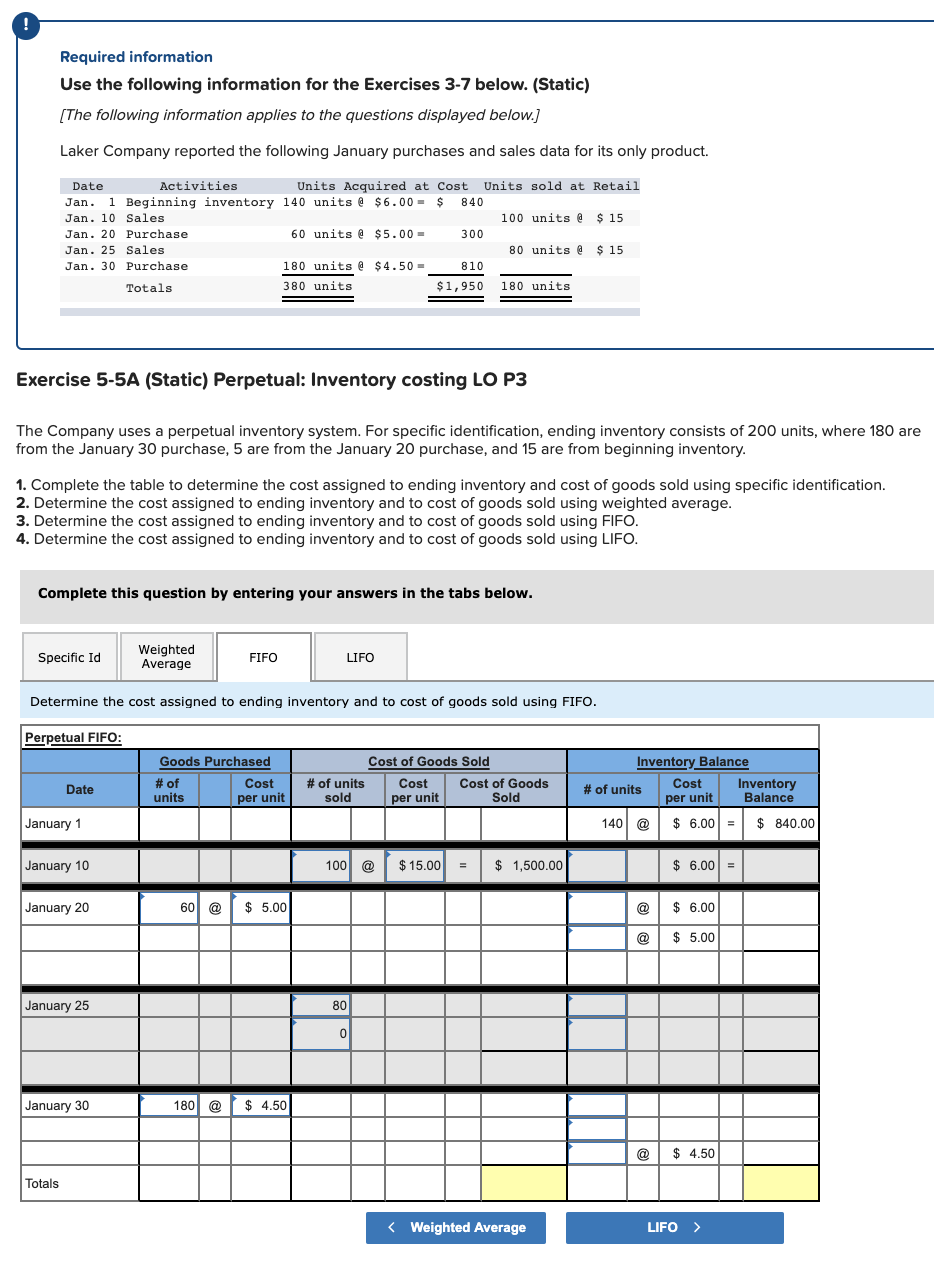Required information Use the following information for the Exercises 3-7 below. (Static) [The following information applies to the questions displayed below.) Laker Company reported the following January purchases and sales data for its only product. Date Activities Units Acquired at Cost Units sold at Retail Jan. 1 Beginning inventory 140 units @ $6.00 = $ 840 Jan. 10 Sales 100 units e $ 15 Jan. 20 Purchase 60 units @ $5.00 = 300 Jan. 25 Sales 80 units @ $ 15 180 units @ $ 4 . 50 = Jan. 30 Purchase 810 Totals 380 units $1,950 180 units Exercise 5-5A (Static) Perpetual: Inventory costing LO P3 The Company uses a perpetual inventory system. For specific identification, ending inventory consists of 200 units, where 180 are from the January 30 purchase, 5 are from the January 20 purchase, and 15 are from beginning inventory. 1. Complete the table to determine the cost assigned to ending inventory and cost of goods sold using specific identification. 2. Determine the cost assigned to ending inventory and to cost of goods sold using weighted average. 3. Determine the cost assigned to ending inventory and to cost of goods sold using FIFO. 4. Determine the cost assigned to ending inventory and to cost of goods sold using LIFO.
Required information Use the following information for the Exercises 3-7 below. (Static) [The following information applies to the questions displayed below.) Laker Company reported the following January purchases and sales data for its only product. Date Activities Units Acquired at Cost Units sold at Retail Jan. 1 Beginning inventory 140 units @ $6.00 = $ 840 Jan. 10 Sales 100 units e $ 15 Jan. 20 Purchase 60 units @ $5.00 = 300 Jan. 25 Sales 80 units @ $ 15 180 units @ $ 4 . 50 = Jan. 30 Purchase 810 Totals 380 units $1,950 180 units Exercise 5-5A (Static) Perpetual: Inventory costing LO P3 The Company uses a perpetual inventory system. For specific identification, ending inventory consists of 200 units, where 180 are from the January 30 purchase, 5 are from the January 20 purchase, and 15 are from beginning inventory. 1. Complete the table to determine the cost assigned to ending inventory and cost of goods sold using specific identification. 2. Determine the cost assigned to ending inventory and to cost of goods sold using weighted average. 3. Determine the cost assigned to ending inventory and to cost of goods sold using FIFO. 4. Determine the cost assigned to ending inventory and to cost of goods sold using LIFO.
Financial And Managerial Accounting
15th Edition
ISBN:9781337902663
Author:WARREN, Carl S.
Publisher:WARREN, Carl S.
Chapter6: Inventories
Section: Chapter Questions
Problem 4TIF: Communication Golden Eagle Company began operations on April 1 by selling a single product. Data on...
Related questions
Question
Confused on how to Determine the cost assigned to ending inventory and to cost of goods sold using FIFO.
and how to Determine the cost assigned to ending inventory and to cost of goods sold using LIFO.

Transcribed Image Text:Required information
Use the following information for the Exercises 3-7 below. (Static)
[The following information applies to the questions displayed below.)
Laker Company reported the following January purchases and sales data for its only product.
Date
Activities
Units Acquired at Cost Units sold at Retail
Jan. 1 Beginning inventory 140 units @ $6.00 = $ 840
Jan. 10 Sales
100 units e $ 15
Jan. 20 Purchase
60 units @ $5.00 =
300
Jan. 25 Sales
80 units @ $ 15
180 units @ $ 4 . 50 =
Jan. 30 Purchase
810
Totals
380 units
$1,950 180 units
Exercise 5-5A (Static) Perpetual: Inventory costing LO P3
The Company uses a perpetual inventory system. For specific identification, ending inventory consists of 200 units, where 180 are
from the January 30 purchase, 5 are from the January 20 purchase, and 15 are from beginning inventory.
1. Complete the table to determine the cost assigned to ending inventory and cost of goods sold using specific identification.
2. Determine the cost assigned to ending inventory and to cost of goods sold using weighted average.
3. Determine the cost assigned to ending inventory and to cost of goods sold using FIFO.
4. Determine the cost assigned to ending inventory and to cost of goods sold using LIFO.
Expert Solution
This question has been solved!
Explore an expertly crafted, step-by-step solution for a thorough understanding of key concepts.
This is a popular solution!
Trending now
This is a popular solution!
Step by step
Solved in 4 steps

Knowledge Booster
Learn more about
Need a deep-dive on the concept behind this application? Look no further. Learn more about this topic, accounting and related others by exploring similar questions and additional content below.Recommended textbooks for you

Financial And Managerial Accounting
Accounting
ISBN:
9781337902663
Author:
WARREN, Carl S.
Publisher:
Cengage Learning,

Financial Accounting
Accounting
ISBN:
9781337272124
Author:
Carl Warren, James M. Reeve, Jonathan Duchac
Publisher:
Cengage Learning

Intermediate Accounting: Reporting And Analysis
Accounting
ISBN:
9781337788281
Author:
James M. Wahlen, Jefferson P. Jones, Donald Pagach
Publisher:
Cengage Learning

Financial And Managerial Accounting
Accounting
ISBN:
9781337902663
Author:
WARREN, Carl S.
Publisher:
Cengage Learning,

Financial Accounting
Accounting
ISBN:
9781337272124
Author:
Carl Warren, James M. Reeve, Jonathan Duchac
Publisher:
Cengage Learning

Intermediate Accounting: Reporting And Analysis
Accounting
ISBN:
9781337788281
Author:
James M. Wahlen, Jefferson P. Jones, Donald Pagach
Publisher:
Cengage Learning

Century 21 Accounting Multicolumn Journal
Accounting
ISBN:
9781337679503
Author:
Gilbertson
Publisher:
Cengage


Financial Accounting: The Impact on Decision Make…
Accounting
ISBN:
9781305654174
Author:
Gary A. Porter, Curtis L. Norton
Publisher:
Cengage Learning